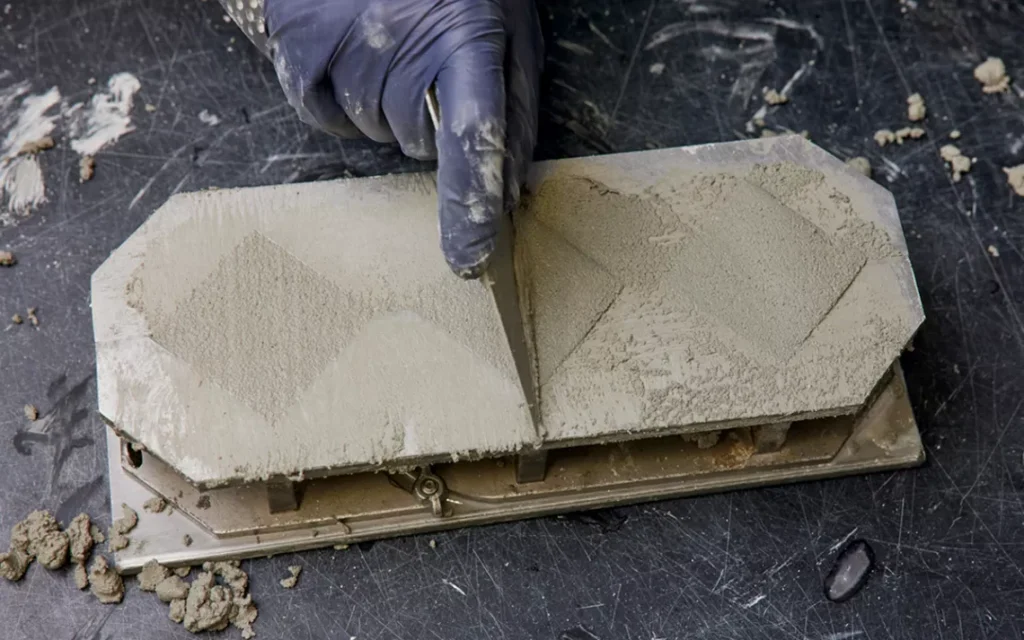And a massive grant from the Department of Energy to soon produce it at an industrial scale
This past June in downtown Boston, a building was nearing completion with an unusual lobby. A bronze-lettered plaque in the concrete floor read, “This floor is the first commercial use of Sublime Cement made with a fossil-fuel-free manufacturing process. A step on this floor is a step closer to our post-carbon future.” Cement production, typically a source of significant carbon emissions, has been reimagined by Sublime Systems. Their pilot plant in Somerville, Massachusetts, has developed a process that avoids traditional emissions.
“Concrete is so prevalent it’s invisible, like the air you breathe,” said Leah Ellis, CEO and cofounder of Sublime, during a plant tour. Since 2020, she and Yet-Ming Chiang have led efforts to make cement more sustainable, using electrochemistry to break down calcium silicate without fossil fuels.

Decarbonized cement is tamped into molds.
Portland cement has been industry standard since the late 1800s, with lime as its core material. The process involves heating limestone in 2,500°F kilns, emitting carbon dioxide. Cement production accounts for at least 8 percent of global emissions; for comparison, aviation is at 2 percent. Decarbonizing cement could have an outsize benefit on emissions reductions.
While several companies are researching cement decarbonization, Sublime leads with a commercial client and a fully decarbonized process, matching Portland cement’s standards. “Same strength, set time, flow, durability,” Ellis noted, without relying on carbon capture.
Ellis, a battery scientist and former Tesla intern, describes the science of using electricity to transform materials as “magic.”

At Sublime’s pilot plant in Massachusetts, technicians manufacture and test small quantities of cement.
In Sublime’s pilot plant, technicians produce small quantities for commercial use, such as downtown slabs. As they scale, their cement could be used in more structural applications. The pilot plant resembles a typical warehouse, with rows of tools and concrete mixers. In a sectioned area, the team refines their process for mortar production.
The process involves weighing Sublime’s carbon-free cement, adding water, and mixing with sand. In May, scientists tested the flow of Sublime’s cement without affecting its strength, using a metal disc and silicone spatula to distribute and test the mixture.
“These test methods for cement are very specific,” remarked Michael Sheahan, a scientist at Sublime.

At Sublime’s pilot plant in Massachusetts, technicians manufacture and test small quantities of cement.
The cement industry lacks a clear career path, notes scientist Summer Camerlo-Bass, who joined Sublime after graduate school to pursue more sustainable work. Sublime’s limited commercial reach is due to production constraints, not lack of interest. This will change in 2026 when Sublime opens a commercial-scale plant in Holyoke, funded by a Department of Energy grant of up to $87 million. This facility will produce tens of thousands of tons of cement annually.

The shape of this cement mortar shows Sublime’s material performed as expected during a strength test.
“When people think of clean tech, they think of wind turbines, solar panels, and EVs. I also want them to think about cement,” Ellis said. Sublime’s cement, lighter due to its production process, contrasts with traditional cement’s color in the lobby of the Boston building.
The Future of Cement
A Quiet Force
Sublime Systems’ pilot plant is in a residential neighborhood. Without hot kilns and harmful gases, it’s safe for locals to visit the nearby brewery.
Industrial Revolution 2.0
Sublime’s upcoming hydroelectric-powered plant in Holyoke, on a former paper mill site, will contribute to the electrification revolution in manufacturing.
Concrete Jungle
Humans produce 30 billion tons of cement annually. The total mass of concrete on Earth may surpass that of all living matter in about 15 years. Concrete is ubiquitous—once you notice it, it’s everywhere.
Original Story at www.sierraclub.org
